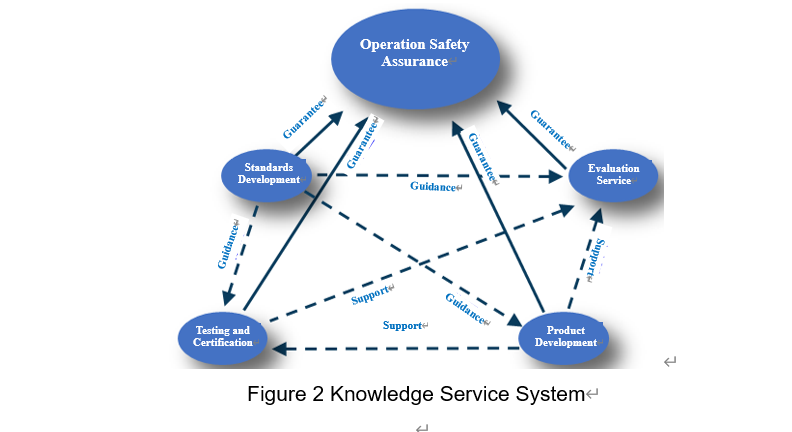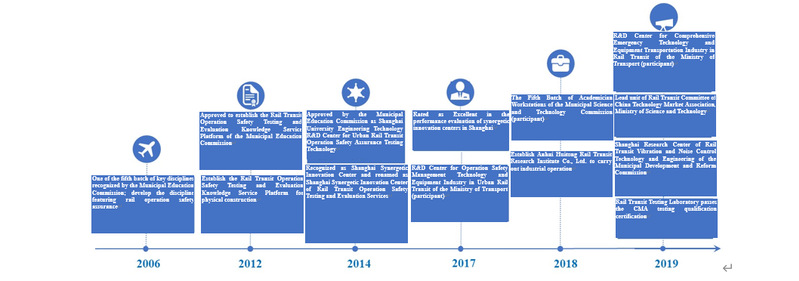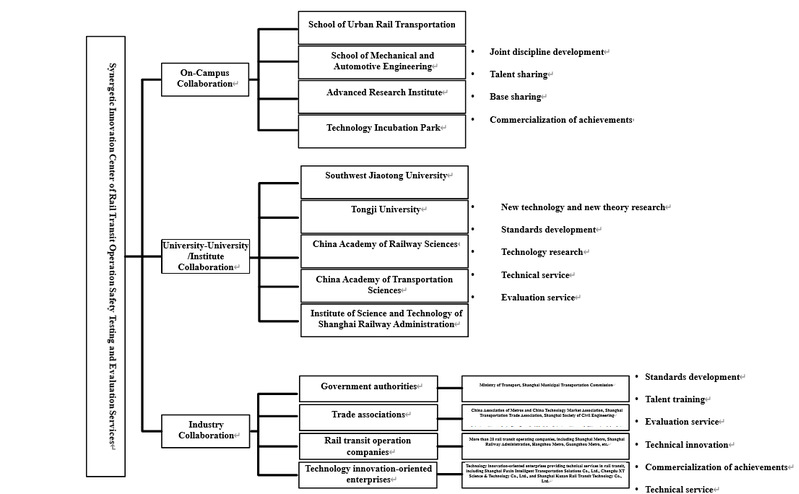1. Development and Organizational Form
The Shanghai Synergetic Innovation Center of Rail Transit Operation Safety Testing and Evaluation Services is a collaborative innovation platform for the modern service industry approved by the Shanghai Municipal Education Commission in 2014. It has become an authoritative operation safety testing and evaluation agency for the rail transit industry, which is “based in Shanghai, focusing on the Yangtze River Delta, and serving China”.

Figure 1 Organizational Framework of the Center
The Center strives to meet the needs of the rapidly developing rail transit industry. It is worth mentioning that Shentong Metro is the major partner of the Center. Shentong Metro is an urban rail company with the longest operating mileage, the largest networked operation scale and the highest level of intelligence in the world. The Center cooperates with universities and public institutions including Southwest Jiaotong University and China Academy of Railway Sciences Corporation Limited to develop major key and core technologies that are used in the safe operation of rail transit in China. As shown in Figure 1, after several years of development and operation, the Center has established a powerful synergetic innovation mechanism and a fully functional organization, and has become a synergetic innovation center that conducts characteristic research and provides exclusive services for the modern service industry. The Center has established a closed-loop knowledge service system for operation safety assurance as shown in Figure 2, and has realized the function of “self-reliance” in terms of evaluation services, testing technology and certification. The vibration and noise reduction products independently developed by the Center enjoy broad market prospects.

The development process of the Center is shown in Figure 3:

Figure 3 Development Process
2. Synergetic Innovation System
The Center takes the operation safety of rail transit as its overarching goal, and is committed to developing key and core technologies and providing first-class services. The Center has established a synergetic innovation system based on shared responsibility and benefit to serve China’s most standardized and networked operating companies. The Center joins hands with universities and research institutes with the highest academic level and strongest technical capabilities to conduct R&D activities and relies on government authorities and associations to carry out industry management.
The Government-Industry-University-Research alliance as shown in Figure 3 has been established. The mission of the Center is to gather and train “rail transit professionals with a global perspective”, team up with partners to create a “hub of technological research and development leading the development of the industry” and build a “whole-chain technical service platform under the background of smart operation and maintenance”. The Center serves the “Yangtze River Delta Integration” national strategy and China’s rail transit companies to meet the needs of national and regional economic and social development. The synergistic relationship and substantive work are shown in Figure 4.

Figure 4 Synergetic Framework
Governments: The Center fully understands the national strategic layout in the field of rail transit and promotes the integration of the Yangtze River Delta by forming a new pattern of rail transit. The Center is entrusted to serve as a third-party assessment agency to play a decision-making support role in rail transit operation safety assurance and industry development.
Companies: The Center cooperates with more than 20 rail transit companies in China, including Shanghai Metro, Shanghai Railway Administration, and Shenzhen Metro, to provide services and technology application and promotion for major projects in rail transit operation safety. Relevant senior engineers have become distinguished researchers and postgraduate supervisors of the Center.
Associations: Linking with industry associations, the Center expands the scope of technical services in China and cooperates with rail transit companies to develop standards and provide consulting services. The Center is a permanent member of China Association of Metros; a deputy permanent member of Shanghai Transportation Trade Association (the secretariat of the Rail Transit Professional Committee of the association is located in the University); a permanent member of Shanghai Society of Civil Engineering; and a founding member of the Rail Transit Committee of China Technology Market Association.
Research institutes: The Center builds the R&D community with research institutes to realize resource sharing and mutual benefit, and provide support for solving technical problems in major rail transit projects. The Center has appointed Professor Lin Jianhui, who was selected in the list of innovative and entrepreneurial talents by the Ministry of Science and Technology, as the long-term Principal investigator. Disciplinary leaders such as high-end talents (National Thousand Talents Program) have been hired as team leaders and the PI system was implemented.
3. Research Contents
The Center focuses on serving the rail transit industry, and strives to develop key technologies in rail transit operation safety testing and break the bottleneck in safety assessment in Shanghai and the rest of China. The Center is committed to building China’s leading and internationally renowned technical service system. The research areas are as follows:
uResearch on the Fault Diagnosis and Control Technology of Rail Vehicles
uResearch on the Theory and Key Technology of Vibration and Noise Control of Track Infrastructure
uRail Transit Testing Equipment Research and Development and Technical Services
uRail Transit Operation Safety Assessment Services
4. Comprehensive Strength
As an authoritative third-party testing and evaluation service organization in the field of rail transit, the Center has an influence in the sector, industry and society.
(1) The Center is the only third-party rail transit safety assessment agency recognized by the government among Chinese universities. It formulates standards and local regulations and provides support for governments and enterprises to make safety management-related decisions.
(2) The Center is the only institution with China Metrology Accreditation (CMA) qualification for third-party testing services in the field of rail transit among universities in East China.
(3) The Shanghai Research Center of Rail Transit Vibration and Noise Control Technology and Engineering of the Municipal Development and Reform Commission, which is incubated by the Center, has a complete industrial chain of vibration and noise reduction products. It has been included in the advanced manufacturing industry cluster of the G60 S&T Innovation Valley under the “Yangtze River Delta” integration strategy. Its vibration and noise reduction products are at the international leading level, which can replace and surpass foreign competing products.
(4) The Center conducts forward-looking research in strict accordance with the strategy of developing China into a transportation powerhouse and the “new infrastructure” system. It has established an online monitoring and early warning platform for rail transit. It has been leading the exploration and industrial transformation of Shanghai Metro’s innovative applications in terms of safety-related big data platforms and smart operation and maintenance.
(5) The Center serves Shanghai Shentong Metro Group Co., Ltd., a world-class rail transit company, and conducts in-depth cooperation with the subsidiaries of the group in terms of operation and maintenance support. Taking the “Shentong Metro Collaboration Experience” as a model, it serves 18 subway companies in China and leads the development of the industry.